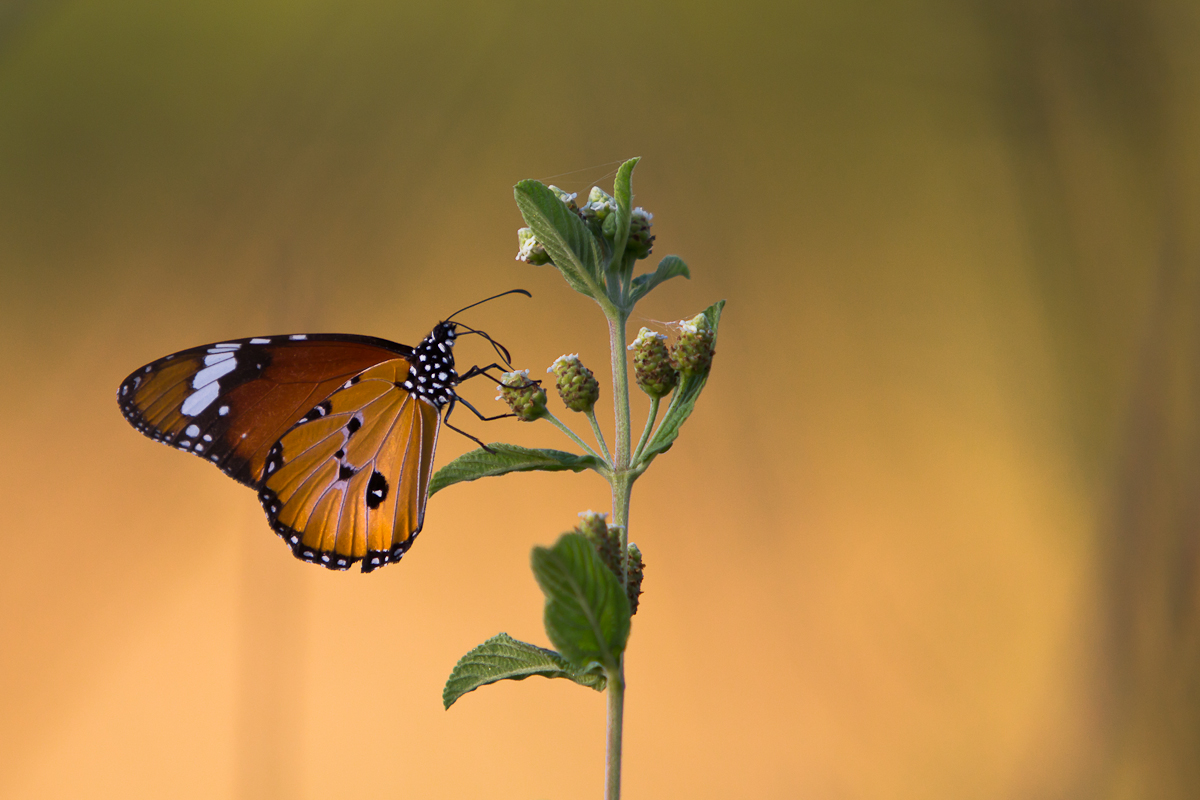the butterfly effect
on Oct 19, 2012“The best things come in small packages.” This is a phrase that is all too true in the natural world and whilst we are graced with some of the most magnificent specimens of animal life here in Africa, it is often the smaller members whose behavior and adaptations amaze guests. Did you know that the beautiful fig trees of the world owe their existence to a 2mm long fig wasp? Or that a male praying mantis is able to continue copulating even after the female has decapitated him? The list of amazing attributes is too plentiful to mention here but it is worth remembering that insects constitute approximately 73% of all species estimated to exist on planet Earth. Throughout the year, one of the more aesthetic orders of insects that we see on safari is the butterfly. Of those, the most frequently seen is the African Monarch (Danaus chrysippus).

This striking member of the butterfly family floats lazily across the bush all year round. Its unusually subdued and relaxed flight pattern is not borne from lethargy but from a self confidence that its toxicity is world renowned. In a miracle of nature, the larval form of the African Monarch feeds on plants from the poisonous milkweed family and somehow, during pupation, retains these toxins in its haemolymph (insect equivalent of blood). An attack on the butterfly would cause it to exhibit a phenomenon known as ‘reflex bleeding’ whereby a noxious liquid is excreted from the body in the hope of repelling the potential predator.

Adorned in orange and black, these contrasting shades are used as a defense mechanism: instead of using camouflage to survive, the Monarch displays itself in all its glory in an attempt to advertise its unpleasant palatability. This is known as ‘aposmatic colouration’ and is prevalent in the insect kingdom due to the excellent colour vision of their avian predators. If you need more convincing, just think of the black and yellow menace, the wasp. If you are met with an unknown buzzing nuisance exhibiting these colours, I guarantee you that you will be wary of leaving the exchange with a nasty sting!

Other species utilize this phenomenon to their advantage in the form of mimicry. The female Diadem butterfly displays almost identical markings to the Monarch but is totally harmless to those looking for a snack. This feigning of danger is known as ‘batesian mimicry’. The opposite is termed ‘mullerian mimicry’ whereby the same markings are exhibited by a similarly unpleasant species in order to reinforce the stigma behind the colours. The bitter acraeas family does exactly this and it is also present closer to home in the bee and the wasp.

Perhaps the most fascinating aspect of the African Monarch’s life is its mating behaviour. Like it or not, this morally questionable species chooses a form of chemical pheromone to subdue his female target. The two sexes are almost indistinguishable but for a raised white dot with black surround on the male’s hind wing. This marking conceals a secretory gland into which he inserts a pair of protrusions from his abdomen. Once armed with his dubious concoction, he brushes the powder over the female’s antennae to induce a ‘relaxed state’, enabling him to complete the act without debate. The same approach used in the human world would culminate in a substantial amount of time spent behind bars...


Insects are often painted as the villains of the natural world. Their list of crimes against humanity stipulates that they are responsible for the destruction of crops, transmitting diseases and generally causing people the ‘heebie geebies’ to name just a few. However, as the old adage goes: “you can’t live with them, you can’t live without them.” This age old phrase is more relevant than most of you might realize... If the world’s insect population was wiped out tomorrow, there would be no life left on this planet within a few decades. A bold statement this may sound but think about it for a moment: 63% of all vertebrates will be gone inside a few weeks due to a lack of food source and soon after, another 30% that rely on the already extinct to survive. Over 85% of flowering plants depend on insects for pollination and therefore will follow suit within a few years and likewise the animals that feed off them. By now, only the grass feeders and decomposers remain. Insects also circulate and oxygenate the soil, so without them, no new soil forms and the top soil is eroded to the bedrock. This spells the end for all the remaining plants and thus all remaining forms of life. So next time you step on a bug, just remember the critical role they play in our environment...







